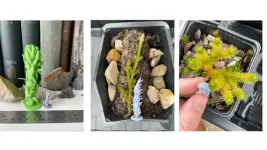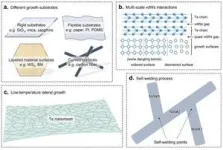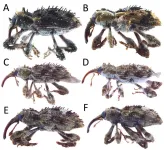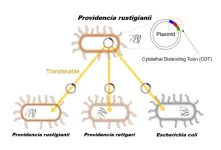(Press-News.org) Leaf arrangements in the earliest plants differ from most modern plants, overturning a long-held theory regarding the origins of a famous mathematical pattern found in nature, research shows.
The findings indicate that the arrangement of leaves into distinctive spirals, that are common in nature today, were not common in the most ancient land plants that first populated the earth’s surface.
Instead, the ancient plants were found to have another type of spiral. This negates a long held theory about the evolution of plant leaf spirals, indicating that they evolved down two separate evolutionary paths.
Whether it is the vast swirl of a hurricane or the intricate spirals of the DNA double-helix, spirals are common in nature and most can be described by the famous mathematical series the Fibonacci sequence.
Named after the Italian mathematician, Leonardo Fibonacci, this sequence forms the basis of many of nature’s most efficient and stunning patterns.
Spirals are common in plants, with Fibonacci spirals making up over 90% of the spirals. Sunflower heads, pinecones, pineapples and succulent houseplants all include these distinctive spirals in their flower petals, leaves or seeds.
Why Fibonacci spirals, also known as nature’s secret code, are so common in plants has perplexed scientists for centuries, but their evolutionary origin has been largely overlooked.
Based on their widespread distribution it has long been assumed that Fibonacci spirals were an ancient feature that evolved in the earliest land plants and became highly conserved in plants.
However, an international team led by the University of Edinburgh has overthrown this theory with the discovery of non-Fibonacci spirals in a 407-million-year old plant fossil.
Using digital reconstruction techniques the researchers produced the first 3D models of leafy shoots in the fossil clubmoss Asteroxylon mackiei – a member of the earliest group of leafy plants.
The exceptionally preserved fossil was found in the famous fossil site the Rhynie chert, a Scottish sedimentary deposit near the Aberdeenshire village of Rhynie.
The site contains evidence of some of the planet’s earliest ecosystems – when land plants first evolved and gradually started to cover the earth’s rocky surface making it habitable.
The findings revealed that leaves and reproductive structures in Asteroxylon mackiei, were most commonly arranged in non-Fibonacci spirals that are rare in plants today.
This transforms scientists understanding of Fibonacci spirals in land plants. It indicates that non-Fibonacci spirals were common in ancient clubmosses and that the evolution of leaf spirals diverged into two separate paths.
The leaves of ancient clubmosses had an entirely distinct evolutionary history to the other major groups of plants today such as ferns, conifers and flowering plants.
The team created the 3D model of Asteroxylon mackiei, which has been extinct for over 400 million years, by working with digital artist Matt Humpage, using digital rendering and 3D printing.
The research, published in the journal Science, was funded by UK Research and Innovation (UKRI), The Royal Society and the German Research Foundation.
The study also involved researchers from, University College Cork, Ireland, University Münster, Germany and Northern Rogue Studios, UK.
Dr Sandy Hetherington, an evolutionary palaeobiologist and the project’s lead at the University of Edinburgh, said:
“Our model of Asteroxylon mackiei lets us examine leaf arrangement in 3D for the first time. The technology to 3D print a 407-million-year old plant fossils and hold it in your hand is really incredible.
“Our findings give a new perspective on the evolution of Fibonacci spirals in plants.”
Holly-Anne Turner, who worked on the project as an undergraduate student at the University of Edinburgh and is first author of the study, said:
“The clubmoss Asteroxylon mackiei is one of the earliest examples of a plant with leaves in the fossil record.
“Using these reconstructions we have been able to track individual spirals of leaves around the stems of these 407 million year old fossil plants. Our analysis of leaf arrangement in Asteroxylon shows that very early clubmosses developed non-Fibonacci spiral patterns.”
Related Links
More information, including a copy of the paper, can be found online at the Science press package at https://www.eurekalert.org/press/scipak/
Dropbox link to video and photos associated with the study: https://www.dropbox.com/scl/fo/b9sxodtrxcfla56h86czo/h?dl=0&rlkey=0pdrd23qnk37w73itryk30t9s
Sandy Hetherington - https://www.ed.ac.uk/biology/groups/hetherington
“Leaves and sporangia developed in rare non-Fibonacci spirals in early leafy plants” Turner et al., Science. DOI 10.1126/science.adg4014
www.science.org/doi/10.1126/science.adg4014
END
Fossil study sheds light on famous spirals found in nature
A 3D model of a 407-million-year-old plant fossil has overturned thinking on the evolution of leaves. The research has also led to fresh insights about spectacular patterns found in plants.
2023-06-16
ELSE PRESS RELEASES FROM THIS DATE:
Racial disparities in lung cancer screening among veterans
2023-06-16
About The Study: The results of this study suggest that Black veterans have lower rates of lung cancer screening that are not fully explained by demographic and socioeconomic variables, underscoring the need for further qualitative studies on barriers to lung cancer screening as well as evidence-based interventions targeted to Black veterans.
Authors: Neelima Navuluri, M.D., M.P.H., of the Duke University School of Medicine in Durham, North Carolina, is the corresponding author.
To access the embargoed study: ...
Experiences of clinicians contending with health care resource scarcity during COVID-19
2023-06-16
About The Study: The findings of this qualitative study suggest that institutional plans to protect frontline clinicians from the responsibility for allocating scarce resources may be unworkable, especially in a state of chronic crisis. Efforts are needed to directly integrate frontline clinicians into institutional emergency responses and support them in ways that reflect the complex and dynamic realities of health care resource limitation.
Authors: Catherine R. Butler, M.D., M.A., of the University of Washington in Seattle, ...
When is migration successful adaptation to climate change?
2023-06-16
A new study by an international team from Africa, Asia and Europe has put forward three criteria for evaluating the success of migration as adaptation in the face of climate change: well-being, equity and sustainability.
The study shows that while migration is increasingly recognised as an effective way to deal with climate risks, or a form of adaptation, it is far from a silver-bullet solution.
For example, remittances – which include flows of money, ideas, skills and goods between migrants and their places of origin – are thought to be key to facilitating adaptation to climate change.
But, drawing on evidence from every continent ...
CityU researchers invent a low-temperature synthesis method for high-quality tellurium nanomesh for next-generation electronics
2023-06-16
A collaborative team led by researchers from City University of Hong Kong (CityU) recently invented an innovative method for synthesizing high-quality, semiconducting nanomesh at a lower temperature and production cost than conventional methods. The findings will help enable the large-scale production of nanomesh for next-generation electronics.
Nanomesh is a nano-scale material formed from a network of nanowires. For several decades, one-dimensional materials like nanowires made of crystalline inorganic materials have been widely explored as the main driver for emerging electronics, as they have features like mechanical flexibility, ...
Endocrine Society Scientific Statement distinguishes normal aging from endocrine disease
2023-06-16
CHICAGO—A new Scientific Statement released today by the Endocrine Society highlights the differences between aspects of aging that are normal and sometimes over-treated, and those such as menopausal symptoms and osteoporosis that can be treated and deserve more attention.
“Hormones and Aging: An Endocrine Society Scientific Statement,” reviews the current state of research on hormonal changes with age. The statement focuses on common endocrine-related changes in older people including menopause and the development ...
Continuous vs intermittent meropenem administration in critically ill patients with sepsis
2023-06-16
About The Study: In critically ill patients with sepsis, compared with intermittent administration, the continuous administration of the antibiotic meropenem did not improve the composite outcome of mortality and emergence of pandrug-resistant or extensively drug-resistant bacteria at day 28.
Authors: Giovanni Landoni, M.D., of the IRCCS San Raffaele Scientific Institute in Milan, Italy, is the corresponding author.
To access the embargoed study: Visit our For The Media website at this link https://media.jamanetwork.com/
(doi:10.1001/jama.2023.10598)
Editor’s ...
Japan’s subtropical forests home to a newly discovered beetle species
2023-06-16
A new weevil species was discovered in Japan’s pristine subtropical forests on Ishigaki Island and Yanbaru National Park in Okinawa.
Renowned for their remarkable biodiversity, the Ryukyu Islands are a chain of subtropical islands distributed between mainland Japan and Taiwan that boast a relatively isolated evolutionary history, and are home to a distinctive and fascinating insect fauna.
Researchers at the Okinawan Institute of Science and Technology (OIST) have been placing net traps to monitor insects on Okinawa ...
Revolutionary new method can manipulate the shape and packing of DNA
2023-06-16
A human cell harbors roughly 2 meters of DNA, encompassing the essential genetic information of an individual. If one were to unwind and stretch out all the DNA contained within a single person, it would span a staggering distance – enough to reach the sun and back 60 times over. In order to manage such an astounding volume of biological information, the cell compacts its DNA into tightly packed chromosomes.
“Imagine DNA as a piece of paper upon which all our genetic information is written.” Says Minke A.D. Nijenhuis, co-corresponding author. “The paper is folded into a very tight structure in order to fit all of that ...
New insights on bacteria that causes food poisoning
2023-06-16
Recently, Providencia spp. which have been detected in patients with gastroenteritis, and similar to enterohemorrhagic Escherichia coli. O157 and Salmonella spp., have been attracting attention as causative agents of food poisoning. For children with low immunity, food poisoning can be lethal as it causes severe symptoms such as diarrhea and dehydration, so clarifying the source of infection and pathogenic factors of Providencia spp., and establishing preventive methods are urgent issues worldwide.
A joint research group led by Professor Shinji Yamasaki, Dr. Sharda Prasad Awasthi, a Specially Appointed Lecturer, and graduate ...
Alcohol and smoking to blame for premature deaths among night owls, 37-year study suggests
2023-06-16
Staying up late at night has little impact on how long ‘night owls’ live, according to new research published in the peer-reviewed journal Chronobiology International.
Data based on nearly 23,000 twins, however shows that evening types have a slightly increased risk of dying than morning types, but this is largely linked to smoking and drinking.
The study which tracked people over the course of more than 37 years in Finland suggests that lifestyle should be considered.
This is when analyzing the impact on health of chronotype – the body’s natural inclination to sleep at a certain time.
“Our ...
LAST 30 PRESS RELEASES:
Smartphone-based interventions show promise for reducing alcohol and cannabis use: New research
How do health care professionals determine eligibility for MAiD?
Microplastics detected in rural woodland
JULAC and Taylor & Francis sign open access agreement to boost the impact of Hong Kong research
Protecting older male athletes’ heart health
KAIST proposes AI-driven strategy to solve long-standing mystery of gene function
Eye for trouble: Automated counting for chromosome issues under the microscope
The vast majority of US rivers lack any protections from human activities, new research finds
Ultrasound-responsive in situ antigen "nanocatchers" open a new paradigm for personalized tumor immunotherapy
Environmental “superbugs” in our rivers and soils: new one health review warns of growing antimicrobial resistance crisis
Triple threat in greenhouse farming: how heavy metals, microplastics, and antibiotic resistance genes unite to challenge sustainable food production
Earthworms turn manure into a powerful tool against antibiotic resistance
AI turns water into an early warning network for hidden biological pollutants
Hidden hotspots on “green” plastics: biodegradable and conventional plastics shape very different antibiotic resistance risks in river microbiomes
Engineered biochar enzyme system clears toxic phenolic acids and restores pepper seed germination in continuous cropping soils
Retail therapy fail? Online shopping linked to stress, says study
How well-meaning allies can increase stress for marginalized people
Commercially viable biomanufacturing: designer yeast turns sugar into lucrative chemical 3-HP
Control valve discovered in gut’s plumbing system
George Mason University leads phase 2 clinical trial for pill to help maintain weight loss after GLP-1s
Hop to it: research from Shedd Aquarium tracks conch movement to set new conservation guidance
Weight loss drugs and bariatric surgery improve the body’s fat ‘balance:’ study
The Age of Fishes began with mass death
TB harnesses part of immune defense system to cause infection
Important new source of oxidation in the atmosphere found
A tug-of-war explains a decades-old question about how bacteria swim
Strengthened immune defense against cancer
Engineering the development of the pancreas
The Journal of Nuclear Medicine ahead-of-print tip sheet: Jan. 9, 2026
Mount Sinai researchers help create largest immune cell atlas of bone marrow in multiple myeloma patients
[Press-News.org] Fossil study sheds light on famous spirals found in natureA 3D model of a 407-million-year-old plant fossil has overturned thinking on the evolution of leaves. The research has also led to fresh insights about spectacular patterns found in plants.







